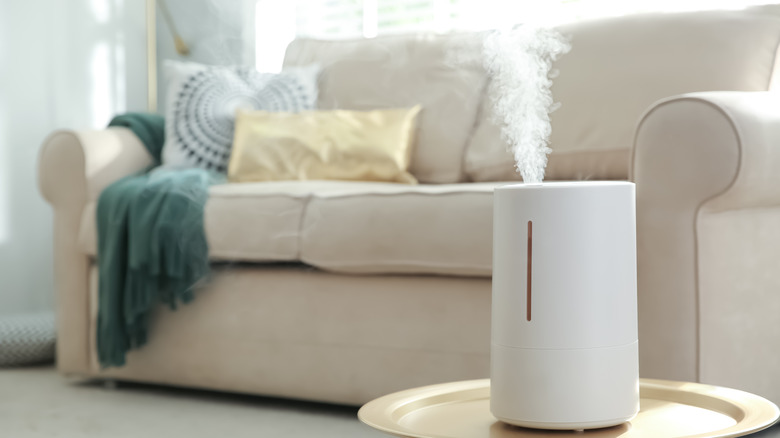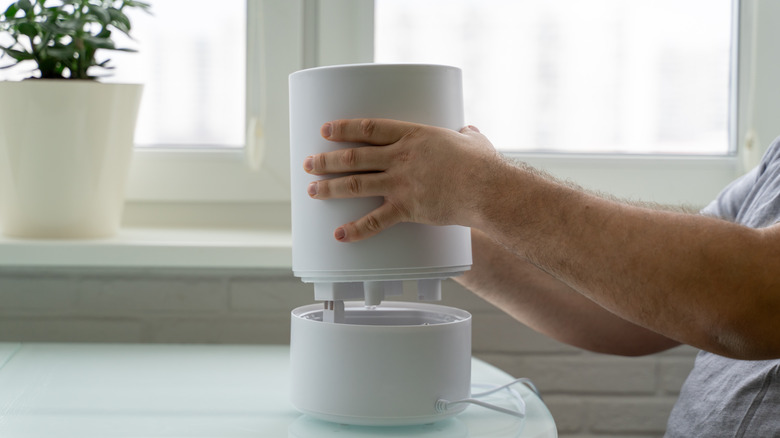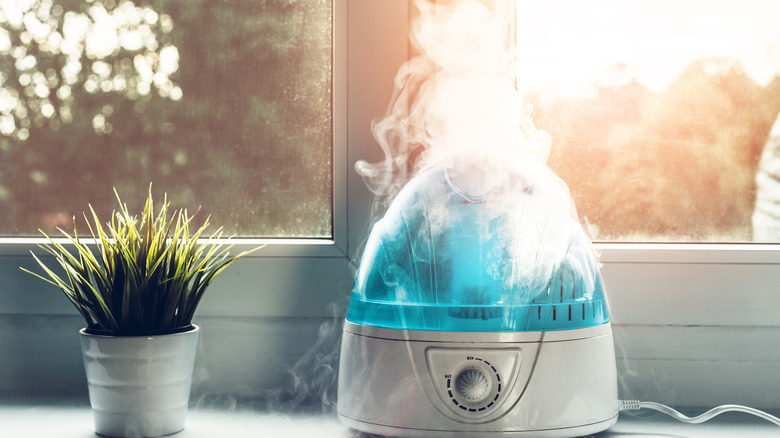How To Clean A Humidifier
If you live someplace where the air is so dry you live with dry skin, occasional nosebleeds, and cracked lips, Mayo Clinic says the way to fix this might be to get a humidifier, which produces steam or vapor in order to add moisture to the air. Other than keeping your skin moist, humidifiers can also offer relief for respiratory problems like a stuffy nose, cough, or sore throat.
But along with the benefits, there are downsides to owning a humidifier, and these problems are mostly created by not maintaining your machine. Just as clean humidifiers help you breathe better, Mayo Clinic warns that unhygienic humidifiers also create condensation, allowing for the culture and spread of organisms including bacteria, dust mites, and mold. A dirty humidifier can lead to a flare-up of allergies and asthma, and can even be problematic for healthy individuals, explains Mayo Clinic.
While there are humidifiers that claim they can resist microbe growth, Consumer Reports says the only way to ensure a humidifier works the way it's meant to, is if it's cleaned regularly.
Aside from preventing germy growth, Pro Housekeepers says cleaning your humidifier means keeping it free of the minerals that might be found in your water, and which could end up compromising the lifespan of what could have been an expensive purchase. But before you tackle your humidifier, remember that there are different types of humidifiers on the market, and each needs to be cleaned in a different way.
How to clean your dehumidifier
The best way to keep your humidifier at its best is to wash it out every day, advises The Maids. To deep clean your humidifier, Consumer Reports suggests you prepare a towel, distilled white vinegar, as well as a cleaning tool like a toothbrush or cotton swabs. It might also help if you use distilled water because it has none of the additives that tap water has, per The Maids.
To start, The Maids says you need to unplug the humidifier and disconnect all the pieces that can be detached. Use water to clean the machine's filter, and a mix of dish soap and water to clean everything else, before leaving the pieces out to air dry. To clean out the water tank, use white vinegar and a toothbrush to clean off hard water mineral deposits as well as any mold or mildew that might have accumulated. Next, rinse the tank with soapy water, then air dry before reassembling.
While some manufacturers may be ok with using bleach to clean a humidifier's reservoir, Consumer Reports suggests treating this advice with some caution. The group's chief scientific officer, James Dickerson, Ph.D. says "Bleach can degrade some plastics and seals that keep the unit watertight and structurally sound." Consumer Reports estimates the entire cleaning process should take about 30 minutes. Pro Housekeeper says these cleaning tips can be used on evaporative humidifiers, cool mist humidifiers, as well as ultrasonic humidifiers.
Cleaning is just the first step
Consumer Reports warn that a quick clean isn't good enough to keep a humidifier working properly and that it needs to be sanitized and disinfected regularly too — at least once a month.
To disinfect your humidifier, Pro Housekeepers says it is best to go with whatever cleaning agent the humidifier's manufacturer recommends. Again, bleach is discouraged here — not just because it could damage the water tank — but it could also leave a potentially toxic residue behind. Instead, the site recommends a solution of four parts water to one part hydrogen peroxide, and leaving that solution in the tank for thirty minutes, before washing the tank thoroughly with clean water and then allowing it to air dry.
Remember not to mix hydrogen peroxide with vinegar at any time during the cleaning process, as it results in the creation of a very toxic chlorine gas.


